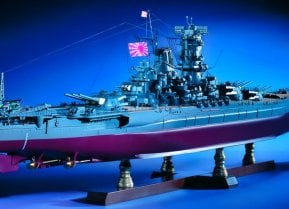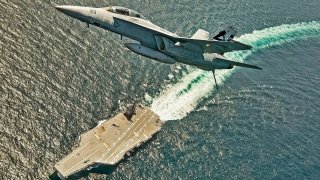The U.S. Navy's New Ford-Class Aircraft Carrier Did a 'Dead-Load' Test
The U.S. Navy's USS John F. Kennedy (CVN-79) Ford-Class aircraft carrier has conducted successful "dead-load" tests using the electromagnetic aircraft launch system (EMALS), launching car-like structures weighing up to 80,000 pounds to simulate aircraft weight.
Summary: The U.S. Navy's USS John F. Kennedy (CVN-79) Ford-Class aircraft carrier has conducted successful "dead-load" tests using the electromagnetic aircraft launch system (EMALS), launching car-like structures weighing up to 80,000 pounds to simulate aircraft weight. This demonstrates a significant advancement over the People's Liberation Army Navy's (PLAN) Type 003 Fujian tests. EMALS, replacing steam catapults on Nimitz-class carriers, shows improved efficiency in launching aircraft. The tests, highlighted by launches exceeding 300 feet at speeds over 150 mph, underline the U.S. Navy's progress in adopting EMALS, positioning the Gerald R. Ford-class carriers at the forefront of naval aviation technology.
Electromagnetic Power: USS John F. Kennedy's Impressive Catapult Tests
Last fall, the People's Liberation Army Navy (PLAN) conducted "dead load" launch tests of its Type 003 Fujian at the Jiangnan shipyard in Shanghai. As previously reported, this involved small test vehicles that were employed from one of the two forward catapult positions on the Fujian's flight deck – and the test vehicle didn't actually take to the skies.
As it is a "dead load," the test vehicle instead it fell into the water basin forward of the ship. However, such tests are common for all catapult-equipped aircraft carriers, both during initial construction and then after major overhauls.
The United States Navy is now putting the future supercarrier USS John F. Kennedy (CVN-79) through similar tests but with apparently significantly larger test platforms.
Last week Huntington Ingalls Industry's Newport News Shipbuilding division began the topside testing of the electromagnetic aircraft launch system (EMALS) on the second Gerald R. Ford-class aircraft carrier. The EMALS was developed to replace the existing steam catapults currently in use on the U.S. Navy's Nimitz-class aircraft carriers.
According to HII, the "no-load" testing on catapults one and two, known as the "bow cats," was successfully completed, and the NNS team, alongside the USS John F. Kennedy crew, began the "dead-load" testing – which involves large, wheeled, car-like structures of graduated weights up to 80,000 pounds to simulate the weight of actual aircraft. These were launched off the flattop's bow into the James River, where they were then retrieved and relaunched until the conclusion of the test program to ensure the catapults were ready for their primary intended purpose, namely to launch all carrier-based fixed-wing aircraft flown by the U.S. Navy, including the F/A-18 Super Hornet and E-2 Hawkeye early-warning plane.
HII shared a video of the launches, and the dead-load vehicles can be seen traveling more than 300 feet down the catapult track on the supercarrier's bow at speeds topping 150 mph, which you can see above.
These initial dead loads used in this month's testing had special significance, as family members of shipbuilders signed them with messages of congratulations and gratitude during the shipyard's Family Day that was held last October.
"As we make sustained progress in the construction, testing and turnover of John F. Kennedy, reaching the dead load testing phase is a visual demonstration of how far we've come," explained Lucas Hicks, vice president, John F. Kennedy ( CVN 79) new construction aircraft carrier program. "It is evident from the thousands of written messages that our shipbuilders and their families appreciate and understand the significance of our work. We are proud of the incredible teamwork that has brought us to this point, and remain committed to delivering this mighty aircraft carrier to the fleet so the crew can carry out the important mission ahead."
In addition to the USS Gerald R. Ford (CVN-78), the CVN-79 is only the second US Navy aircraft carrier to feature the new electromagnetic aircraft launch system, a more efficient mechanism for launching fixed-wing aircraft more effectively than its steam-powered predecessors aboard Nimitz-class carriers.
The United States Navy struggled during the "learning curve" stage during the construction and testing of CVN-78, but based on the recent tests it does appear that the issues with the EMALS have been largely resolved. However, it is unclear if the PLAN will face delays with the Type 003 Fujian, as it is the only other carrier to employ an electromagnetic launch system.
Author Experience and Expertise: Peter Suciu
Peter Suciu is a Michigan-based writer. He has contributed to more than four dozen magazines, newspapers, and websites with over 3,200 published pieces over a twenty-year career in journalism. He regularly writes about military hardware, firearms history, cybersecurity, politics, and international affairs. Peter is also a Contributing Writer for Forbes and Clearance Jobs. You can follow him on Twitter: @PeterSuciu. You can email the author: [email protected].


